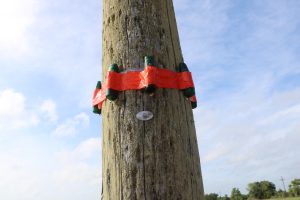The Smart Wind Engineering Research Facility (SWERF) is currently being developed by the Wind Engineering Research Laboratory to support our own research and fill the demand for full-scale validation of wind tunnel and numeric simulations.
This page provides an overview of the equipment associated with the facility.
10-meter Tower

The Wind Engineering Research Laboratory is actively collecting data at SWERF from a 10-meter tower with propeller anemometers at 3 levels (2 meters, 4 meters, and 10 meters); and relative humidity, pressure, and temperature sensors (located at 4 meters level).
Mobile 10-meter Tower (temporary)
The 10-meter tower was deployed at SWERF between June 2 and October 3 of 2016. This mobile tower was on loan from the University of Florida’s Florida Coastal Monitoring Program.

The Wind Engineering Research Laboratory collected 82 non-consecutive days of data using the 10-meter tower’s propeller anemometer arrays (at five and ten meters), temperature, relative humidity, and pressure sensors.
50-meter Tower

Initially, the 50-meter tower will be equipped with propeller anemometer arrays, pressure sensors, and temperature sensors at five levels and a relative humidity sensor at the lowest level. These sensors will provide the baseline and reference measurements needed for most other experimentation and provide continuous monitoring of conditions.
The tower is expected to be operational in the near future. Additional sensors may be added based on future needs.
Low-rise Building

A low-rise CMU building, approximately 43-feet by 35-feet, is being renovated at the SWERF site to house data collection and serves as a foundation for full-scale experimentation.
m-SWERF tower
The m-SWERF tower is a mobile meteorological tower with a set of u v w RM Young anemometers, a barometric pressure, relative humidity, and temperature sensors.

m-SWERF³
m-SWERF³ is a mobile instrumented bluff-body capable of measuring wind-induced pressure in the four walls and on the roof. Continuous progress is being made to guarantee rapid deployment and the acquisition of reliable data during extreme wind events.

Barometric pressure sensors
Fully mobile off the shelf barometric pressure sensors that can be used for many different applications. Direct measurement of atmospheric pressure, wind speed estimation, and loading characterization.

Sustainability
As wind engineers, our primary contribution to sustainability will be facilitating the design of more resilient structures – structures that continue to serve their primary function after a severe wind event. This goal is second only to the safety and preservation of life.
The Wind Engineering Research Laboratory is also committed to constructing SWERF with sustainability in mind. We will achieve this by designing our facilities such that each development is adaptable to future needs and by responsibly sourcing materials.
SWERF itself is located on part of the decommissioned Chanute Air Force Base, an EPA Superfund site. The low-rise building that will house SWERF’s data collection is a rehabilitated structure formerly used by the Air Force base, and the 50-meter tower was relocated from a site less than two miles from SWERF.
